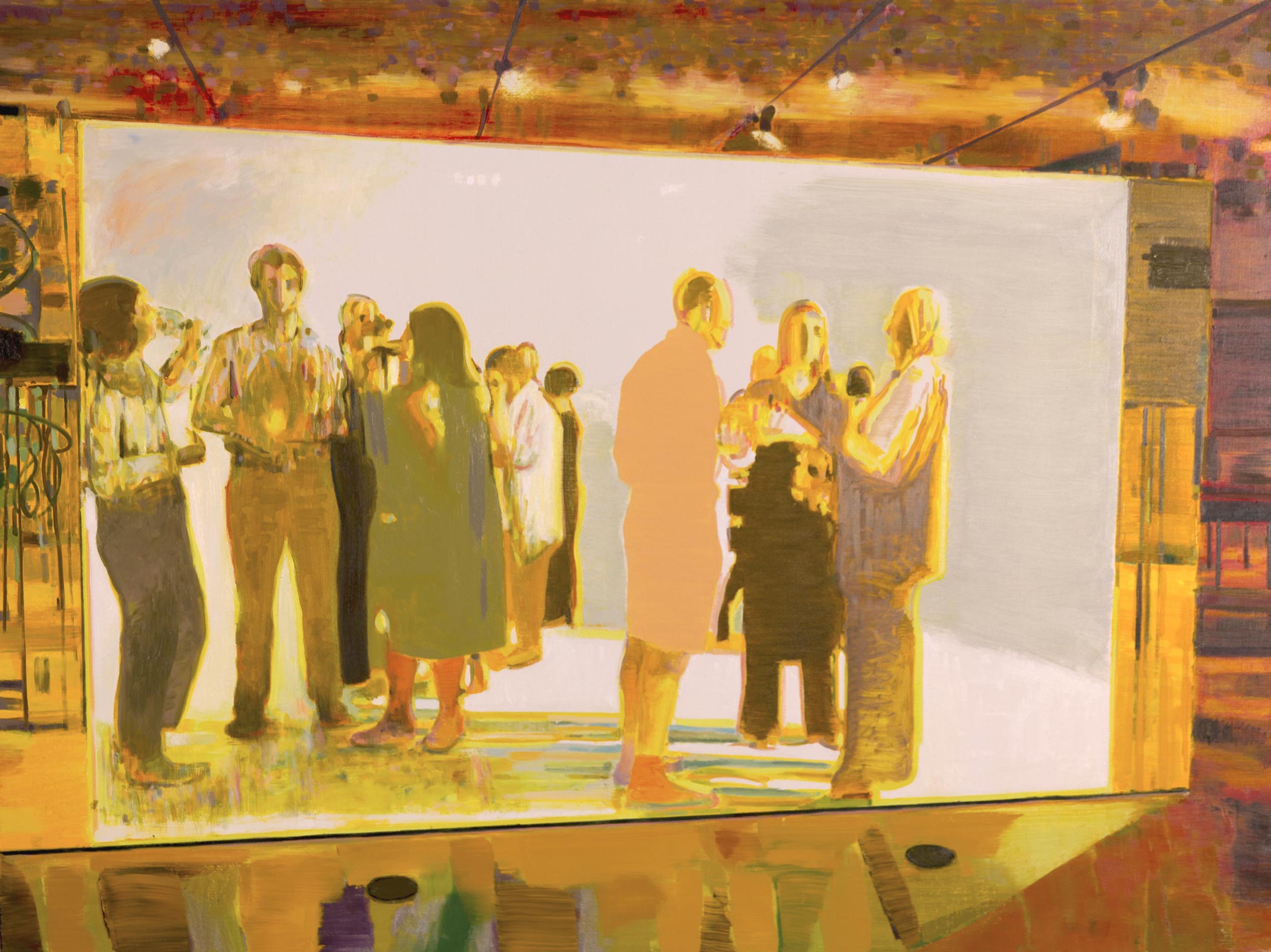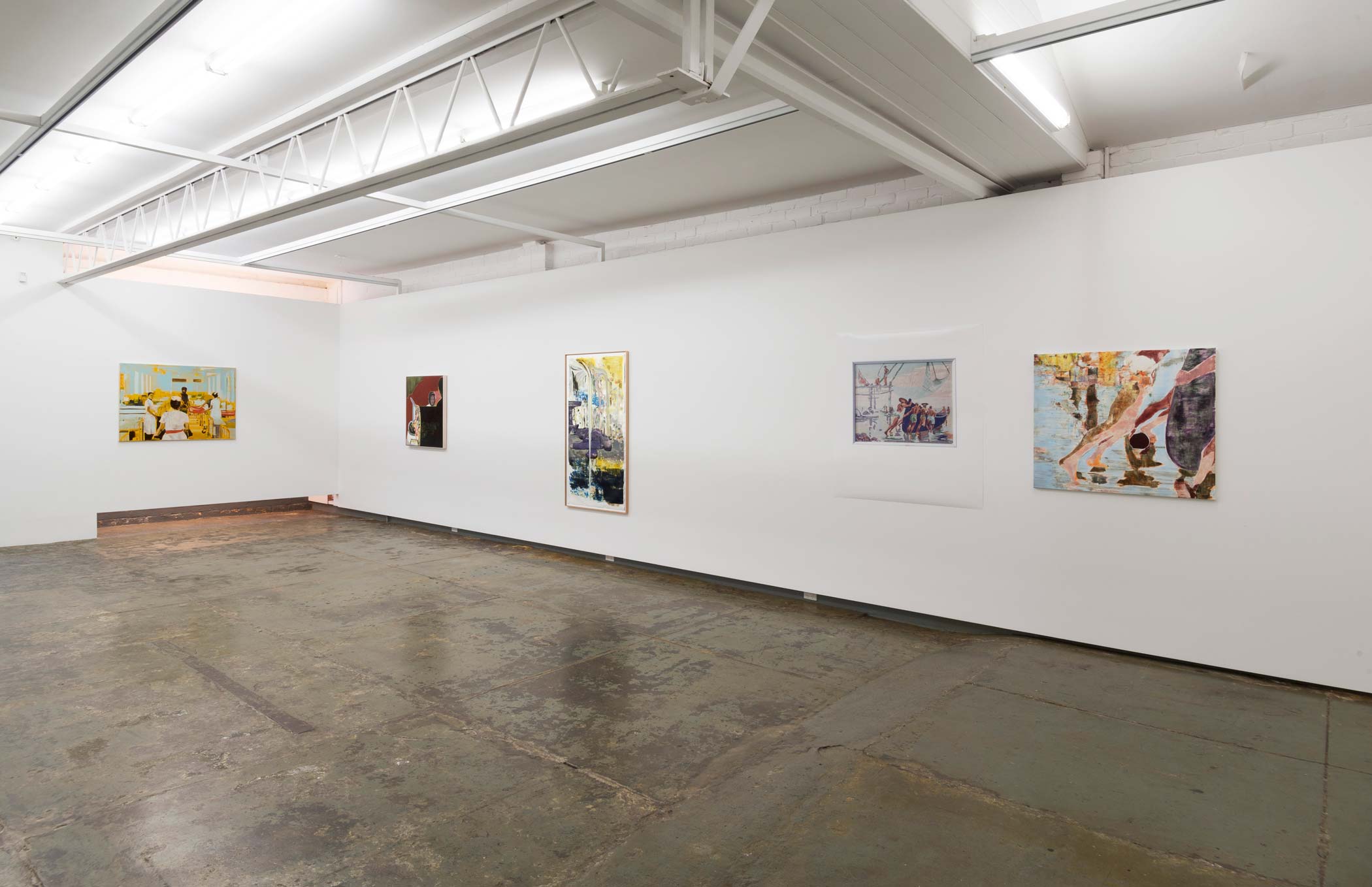The Poor Hospital (passage and fate) 2015
Blockprojects Gallery, Melbourne, Australia







Peter Westwood’s painting The poor hospital could be about pity, or our ability to feel for the plight of others.
The painting is an acrid yellow field with an overlay of floating pale blue structural forms and from a group of figures in the centre, someone stares straight at us. A nurse looking sideways has her gaze fixed firmly upon ours. Her intention however is not clear, for she may be seeking our assistance, revoking us for our role as ineffectual observers, or she may equally be standing defiant, rejecting any judgement.
However we read this painting, in whatever way we interpret the word ‘poor’, we are complicit. The nurse’s gaze locks us into a silent dialogue, and we know that this is our hospital, that we have some- how permitted its impoverishment.
Peter Westwood’s exhibition, The Poor Hospital (passage and fate), takes its name from the yellow painting with the nurse and examines the complex, networked and ambiguous nature of our personal and societal relationship to power. A key image in this exhibition is the two-part work Our fathers affect, one section of which is a photograph of a framed ‘paint-by-numbers’ picture made by Westwood’s father in the 1960’s, the other a delicately painted schematic rendering made by Westwood in response to his father’s work. Our own relationship to power begins with family, and the idea of ‘the father’s hand’ - a symbol of both hierarchical power and inherited trauma – is a motif Westwood has employed overtly and discretely within his work for several decades. In this work we are alerted to the paradox of homage, it is both an act of respect and erasure as the power of the image irrevocably alters through reproduction.
Photography as a kind of cipher, appears in other works throughout the exhibition. A framed photographic image of lurid pink goo hangs alongside a large painting of an intricate medieval interior, where the golden-headed reliquaries of Saints, those ordinary people who once did something miraculous, sit on shelves guarded by a middle-aged woman. The close up photograph of what is in fact hot pink coloured carpenter’s glue with its distinctive pulled sticky peaks (itself a miraculous sealant, a chemical mixture so strong that it can hold together walls) is as meaningful to contemporary society as are the bones of long dead Saints; both offer the hopeful promise of permanency, the alchemical power to transform.
The gooey messy stuff of life; that which we are in, and that which we cannot see that we are in, distracts and consumes us, obfuscating the sources and meaning of power. Westwood has followed with fascination the discourses surrounding citizen-led uprisings such as the recent global ‘occupy’ movement, and the utopian driven language of the now radically re-imagined Arab Spring, as these very attempts to break with authority find themselves subsumed by the forces of power they seek to resist. In a large three-panel work, The problems of repair, we find a cluster of small coloured forms surrounded by a maelstrom of marks. Resisting the totalising effect of their circumstance these coloured shapes operate as a still-point in time, and are a metaphor for the present. Spaced in between past and future it is unclear whether these forms are the last, or the first of their kind. On the left hand side of this large canvas sits a small wooden panel showing masked workers occupied with something that sits outside of the picture-frame. On the other side sits a photograph of a mass-produced wall poster that has been almost entirely over painted. Amusingly the alignment of the images suggests that the men might be at work on the large abstract painting, they crouch with arms extended, holding their industrial equipment in a gesture that suggests both manufacture and restoration. Perhaps these workers will complete Westwood’s indeterminate abstraction?
![]()
The painting is an acrid yellow field with an overlay of floating pale blue structural forms and from a group of figures in the centre, someone stares straight at us. A nurse looking sideways has her gaze fixed firmly upon ours. Her intention however is not clear, for she may be seeking our assistance, revoking us for our role as ineffectual observers, or she may equally be standing defiant, rejecting any judgement.
However we read this painting, in whatever way we interpret the word ‘poor’, we are complicit. The nurse’s gaze locks us into a silent dialogue, and we know that this is our hospital, that we have some- how permitted its impoverishment.
Peter Westwood’s exhibition, The Poor Hospital (passage and fate), takes its name from the yellow painting with the nurse and examines the complex, networked and ambiguous nature of our personal and societal relationship to power. A key image in this exhibition is the two-part work Our fathers affect, one section of which is a photograph of a framed ‘paint-by-numbers’ picture made by Westwood’s father in the 1960’s, the other a delicately painted schematic rendering made by Westwood in response to his father’s work. Our own relationship to power begins with family, and the idea of ‘the father’s hand’ - a symbol of both hierarchical power and inherited trauma – is a motif Westwood has employed overtly and discretely within his work for several decades. In this work we are alerted to the paradox of homage, it is both an act of respect and erasure as the power of the image irrevocably alters through reproduction.
Photography as a kind of cipher, appears in other works throughout the exhibition. A framed photographic image of lurid pink goo hangs alongside a large painting of an intricate medieval interior, where the golden-headed reliquaries of Saints, those ordinary people who once did something miraculous, sit on shelves guarded by a middle-aged woman. The close up photograph of what is in fact hot pink coloured carpenter’s glue with its distinctive pulled sticky peaks (itself a miraculous sealant, a chemical mixture so strong that it can hold together walls) is as meaningful to contemporary society as are the bones of long dead Saints; both offer the hopeful promise of permanency, the alchemical power to transform.
The gooey messy stuff of life; that which we are in, and that which we cannot see that we are in, distracts and consumes us, obfuscating the sources and meaning of power. Westwood has followed with fascination the discourses surrounding citizen-led uprisings such as the recent global ‘occupy’ movement, and the utopian driven language of the now radically re-imagined Arab Spring, as these very attempts to break with authority find themselves subsumed by the forces of power they seek to resist. In a large three-panel work, The problems of repair, we find a cluster of small coloured forms surrounded by a maelstrom of marks. Resisting the totalising effect of their circumstance these coloured shapes operate as a still-point in time, and are a metaphor for the present. Spaced in between past and future it is unclear whether these forms are the last, or the first of their kind. On the left hand side of this large canvas sits a small wooden panel showing masked workers occupied with something that sits outside of the picture-frame. On the other side sits a photograph of a mass-produced wall poster that has been almost entirely over painted. Amusingly the alignment of the images suggests that the men might be at work on the large abstract painting, they crouch with arms extended, holding their industrial equipment in a gesture that suggests both manufacture and restoration. Perhaps these workers will complete Westwood’s indeterminate abstraction?




Figures 1-4. Installation views
Throughout The Poor Hospital (passage and fate) paint as substance – as messy, sticky, dry, slippery matter – reinforces and replicates the uncertain nature of contemporary life. There is a sense of reverberation in these paintings, the paint is applied in the same manner in which knowledge is accumulated, through effort and accident, layered in places, densely amassed, while in others the marks are sparse. The paintings appear to be formed in and of the moment, as if they are only one of many possible solutions. By recognizing that we can’t really know the world in which we live, we can consider the possibility that paint can give form to an alternative type of knowledge. In Passivity; after ‘an episode from a fight’ voluptuous and flaccid conical forms reminiscent of the pink peaks made from the carpenter’s glue in Reliquaries, rise and fall across the picture plane, beneath which a dead figure lies; a once significant character from a war in the middle of the previous century. In this image we find again homage on Westwood’s part, this time to Edouard Manet. The Dead Toreador (1864) is a painting in which Manet positions the body of a dead bull fighter diagonally across a very shallow picture plane, in much the same manner as Westwood does with his dead commandant. In both pictures the figures float without context, in Manet’s a dark field engulfs the toreador, in Westwood’s a miasma erupts and cascades. However, in Westwood’s painting the vortex-like, psychedelic background reminds us that, despite his notoriety, this figure is just another moment in history.
The artist as the subject and object of power is playfully teased out in The painting, the photograph – the whole shebang, a portrait of Belgian artist Luc Tuymans. Made from a press photograph Westwood encountered of Tuymans after the artist was found guilty of plagiarism through his use of a press photograph as the subject for his painting, A Belgian politician (2011)1. Having built a career around making paired back, enigmatic paintings about the world in which we live by using images from that world, Tuymans, his lawyers and the art world were confounded by the court decision. For Westwood the pre-eminent questions arising from the Tuymans case form through the circular and recurring discourses of power and money. Painted in gold, silver and bronze The painting, the photograph – the whole shebang positions Tuymans at the centre of a power struggle that should be familiar to us: this is the dialectical relationship between the individual and the system, this is the poor hospital.
— Julia Powles, 2015
Notes
1. In reference to a photograph by Alex Salinas.